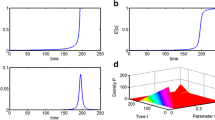Abstract
Concomitant resistance is a tumor growth dynamic which results when the growth of a second tumor implant is inhibited by the presence of the first. Recently, we modeled tumor growth in the presence of a regenerating liver after partial hepatectomy (Michelson and Leith,Bull. Math. Biol. 57, 345–366, 1995), with an interlocking pair of growth control triads to account for the accelerated growth observed in both tissues. We also modeled tumor dormancy and recurrence as a dynamic equilibrium achieved between proliferating and quiescent subpopulations. In this paper those studies are extended to initially model the concomitant resistance case.
Two interlocking model systems are proposed. In one an interactive competition between the tumor implants is described, while in the other purely proportional growth inhibition is described. The equilibria and dynamics of each system when the coefficients are held constant are presented for three subcases of model parameters.
We show that the dynamic called concomitant resistance can be real or apparent, and that if the model coefficients are held constant, the only way to truly achieve concomitant resistance is by forcing one of the tumors into total quiescence. If this is the true state of the inhibited implant, then a non-constant recruitment signal is required to insure regrowth when the inhibitor mass is excised. We compare these theoretical results to a potential explanation of the phenomenon provided by Prehn (Cancer Res. 53, 3266–3269, 1993).
Similar content being viewed by others
References
Asaga, T., K. Suzuki, M. Umeda, Y. Sugimasa, S. Takemiya and T. Okamoto. 1991. The enhancement of tumor growth after partial hepatectomy and the effect of sera obtained from hepatectomized rats on tumor cell growth.Japanese J. Surg. 21, 669–675.
Ehrlich, P. 1906. Experimentelle Coarcinomatuien an Mausen.Arb. Koniglichen Inst. Exp. Ther. Frankfurt,1, 65–103.
Fisher, B. and E. R. Fisher. 1959. Experimental studies of factors influencing hepatic metastases II. Effect of partial hepatectomy.Cancer 12, 929–932.
Gorelik, E. 1983. Concomitant tumor immunity and resistance to a second tumor challenge.Adv. Cancer Res. 39, 71–120.
Gyllenberg, M. and G. F. Webb. 1990. A nonlinear structured population model of tumor growth with quiescence.J. Math. Biol. 28, 671–694.
Leith, J. T., G. Padfield and S. Michelson. 1992. Effects of partial hepatectomy on the growth characteristics and hypoxic fractions of xenografted DLD-2 human colon cancers.Rad. Res. 132, 263–268.
Michelson, S. and J. T. Leith. 1991. Autocrine and paracrine growth factors in tumor growth.Bull. Math. Biol. 53, 539–656.
Michelson, S. and J. T. Leith. 1992a. The autocrine-paracrine-endocrine triad of tumor growth control.Proceedings of Third International Conference on Communications and Control, Victoria, B.C., 16–18 October 1991, Vol. 2, pp. 481–490.
Michelson, S. and J. T. Leith. 1992b. Growth factors and growth control of heterogeneous cell populations.Bull. Math. Biol. 55, 993–1011.
Michelson, S. and J. T. Leith. 1994. Dormancy, regression, and recurrence: towards a unifying theory of tumorgrowth control.J. Theor. Biol. 169, 327–338.
Michelson, S. and J. T. Leith. 1995. Interlocking triads of growth control in tumors.Bull. Math. Biol. 57, 345–366.
Namieno, T., N. Takeichi, Y. Hata, J. Uchinao and H. Kobayashi. 1991. Kinetic changes of liver regeneration and hepatocellular carcinoma cells after partial hepatectomy in rats.Gastroenterologia Japonica 26, 29–36.
Paschkis, K. E., A. Cantarow, J. Stasney and J. H. Hobbs. 1955. Tumor growth in partially hepatectomized rats.Cancer Res. 15, 579–582.
Prehn, R. T. 1991. The inhibition of tumor growth by tumor mass.Cancer Res. 51, 2–4.
Prehn, R. T. 1993. Two competing influences that may explain concomitant tumor resistance.Cancer Res. 53, 3266–3269.
Roberts, A. B., M. A. Anzano, L. M. Wakefield, N. S. Roche, D. F. Stern and M. B. Sporn. 1985. Type beta transforming growth factor: a bifunctional regulator of cellular growth.PNAS 82, 119–123.
Ruggerio, R. A., O. D. Buatuoabad, R. D. Bonfil, R. P. Meiss and C. D. Pasqualini, 1985. “Concomitant immunity” in murine tumors of non-detectable immunogenicity.Br. J. Cancer 51, 37–48.
Sordelli, D. O., P. A. Fontan, R. P. Meiss, R. A. Ruggerio and O. D. Buatuoabad. 1989. Anti-inflammation induced by counter irritation or by treatment with non-steroidal agents inhibits the growth of a tumor of non-detected immunogenicity.Br. J. Cancer 60, 734–738.
Webb, G. F. 1992. A nonlinear cell population model of periodic chemotherapy treatment.WSSIAA 1, 569–583.
Author information
Authors and Affiliations
Rights and permissions
About this article
Cite this article
Michelson, S., Leith, J.T. A theoretical explanation of “Concomitant resistance”. Bltn Mathcal Biology 57, 733–747 (1995). https://doi.org/10.1007/BF02461849
Received:
Accepted:
Issue Date:
DOI: https://doi.org/10.1007/BF02461849




